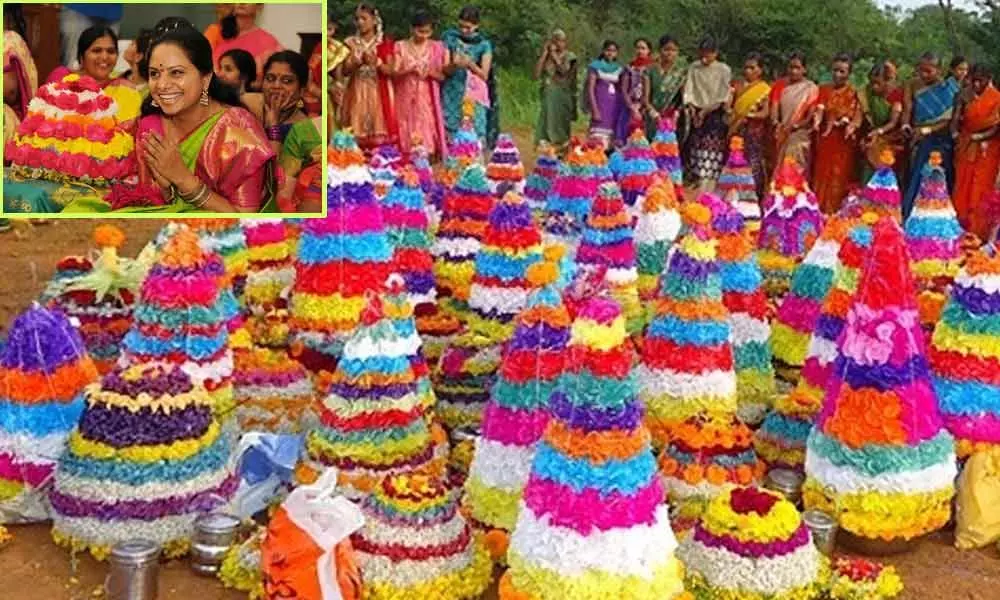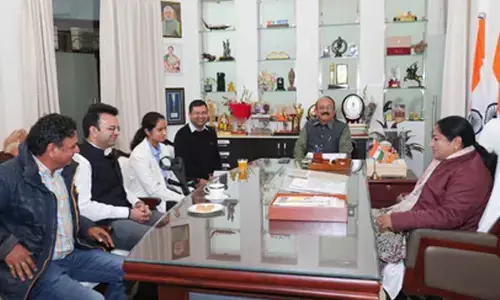Telanganites to celebrate the Saddula Bathukkamma today- Bathukkama Sambaralu 2019

Bathukamma is observed during the Durga Navaratri period and ends two days before Dussehra, from Mahalaya Amavasya to Durgashtmi, known as "Saddula Bathukamma" or "Pedda Bathukamma". Boddemma is a 7 day festival which follows Bathukamma.
Bathukamma is observed during the Durga Navaratri period and ends two days before Dussehra, from Mahalaya Amavasya to Durgashtmi, known as "Saddula Bathukamma" or "Pedda Bathukamma". Boddemma is a 7 day festival which follows Bathukamma. Bathukamma ushers in Sharath Ruthu and Bodemma concludes Varsha Ruthu.
The 'shilpakka pandlu' (or 'sitaphalalu'), custard apples, are another great attraction during this season. The custard apple is tasty fruit that grows in the wild with little or no water and is often called the 'poor man's apple'. Then there is corn ('jonna' and 'mokka jonna') waiting to be harvested.
Amidst these, Bathukamma is celebrated by the womenfolk of Telangana, heralding the beauty of vibrant nature in multitudinous flowers.
This unique festival celebrates the inherent relationship between earth, water and the human beings. During the entire preceding week, women make 'boddemma' (a deity of Gowri – mother Durga – made with earthly mud) along with Bathukamma and immerse it in the ponds. This helps reinforce the ponds and helps it retain more water. Boddemma festival marks the ending of Varsha Ruthu whereas Bathukamma festival indicates the start of Sharath Ruthu.
Bathukamma is a beautiful flower stack, arranged with different unique seasonal flowers most of them with medicinal values, in seven concentric layers in the shape of temple gopuram. In Telugu, 'Bathukamma' means 'Mother Goddess come Alive' where Goddess Maha Gauri - 'the Life Giver' is worshipped in the form of Bathukamma.
For one whole week, they make small 'Bathukammas', play around them every evening and immerse them in a nearby water pond. On the last day, menfolk of the house go into the wild plains and gather the flowers like 'gunuka' and 'tangedu'. They bring home bagfuls of these flowers and the entire household sits down to arrange them in stacks.
The flowers are carefully arranged row after row in a brass plate (called 'taambalam') in circular rows and in alternate colours. The Bathukamma grows in size and the bigger it gets the better. The white 'gunuka' flowers are coloured using water paints and Bathukamma gets colourful circular layers of them along with 'tangedu' in between. The Bathukamma is then placed before the family deity and prayers are offered.
As evening approaches the womenfolk dress colorfully in best of their attire and adorn lot of ornaments and place the Batukamma in their courtyard. The women of neighborhood also gather in a large circle around it. They start singing songs by making rounds around them repeatedly, building a beautiful human circle of unity, love, sisterhood.
After playing in circles around the 'Batukammalu', before the onset of dusk, the womenfolk carry them on their heads and move as a procession towards a bigger water body near the village or town. The procession is extremely glittering with aptly dressed and decorated women and 'Bathukammalu' . Songs of folklore are sung in chorus throughout the procession and the streets resonate with them.
Finally, when they reach the water pond the 'Bathukammalu' are slowly immersed into water after another round of playing and singing. Then they share the 'maleeda' (a dessert made with sugar or raw sugar and corn bread) sweets amongst the family members and neighborhood folks. They return to their homes with empty 'taambaalam' singing songs in praise of Bathukamma. The songs of Bathukamma echo in the streets until late night during the entire week.
Bathukamma is a celebration of the inherent relationship human beings share with earth and water. During the entire preceding week, women make 'boddemma' (a deity of Gowri 'mother Durga' made with earthly mud) along with Bathukamma and immerse it in the pond. This helps reinforce the ponds and helps it retain more water.
The flowers used in Bathukamma have a great quality of purifying water in ponds and tanks and flowers so immersed in abundance are environment friendly.
On this special occasion women dress up in the traditional sarees, accompanied by traditional jewels and other accessories. The ninth day of Bathukamma, Saddula Bathukamma is celebrated on the eight day of Ashwayuja masam, coinciding with festival of Durgashtami. The offerings made on this day involves five different types of cooked rice dishes like perugannam saddi (curd rice), chinthapandu pulihora saddi (tamarind rice), nimmakaya saddi (lemon rice), kobbara saddi (coconut rice) and nuvvula saddi (sesame rice).
The festival begins a week before the 'Saddula Bathukamma' (the grand finale of the Bathukamma festival) which falls two days before Dassera. The womenfolk normally get back to their parents'homes from their in-laws and breathe the fresh air of freedom to celebrate the colours of flowers.
This year Saddula Bathukamma is being celebrated on September October 6 th. The final immersion of Bathukamma is done today in lakes and ponds, by the faithful in the state of Telangana.
On this final day, immersion of Bathukamma (Bathukamma Visarjan/Nimarjanam) in water bodies is done with utmost devotion while rhythmic drum beats throughout the cities and towns of Telangana. The evening, on the day of Saddula Bathukamma offers a charming and peaceful visual treat. Gowramma, which is a symbolic idol of Goddess Gowri made of turmeric is separated from the Bathukamma before immersion and married women apply this on their Mangala sutra which marks the solemnization of their marriage,
accompanied by a wish that their husbands should be protected from any evils and ill fate. Maleeda, which is a combination of Roti and Jaggery, is prepared on this grand day and distributed at the end of the day, marking the formal end of Bathukamma festivities.
The festival heralds the beauty of nature, collective spirit of Telangana people, the indomitable spirit of womenfolk and also the ecological spirit of the agrarian people in preserving the natural resources in a festive way.

















